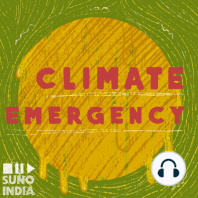43 min listen

When the Ice Melts Part 1: Longest field data analyses regional climate change in Chhota Sigri glacier of the Himalaya
When the Ice Melts Part 1: Longest field data analyses regional climate change in Chhota Sigri glacier of the Himalaya
ratings:
Length:
20 minutes
Released:
Jan 30, 2021
Format:
Podcast episode
Description
In a recent paper published in the Journal of Glaciology, scientists have reported their findings from the longest ever field data from the entire Himalayan range for the first time. Chhota Sigri, a key benchmark glacier or an indicator glacier for the Lahaul-Spiti region in Himachal Pradesh, was studied to understand the effect of climate change. The data looked at various components of the glacier like mass balance, ice velocity, high altitude meteorology, glacier runoff, and their interactions with climate change.
The glacier is losing its ice mass like other glaciers in the world. However, it’s not as bad as previous studies have pointed out.
Also, based on The Intergovernmental Panel on Climate Change (IPCC) report that the Himalayan glaciers would be gone soon, it was found that the glaciers would not really disappear as predicted or talked about. The study revealed that glacier health depends on fluctuations in air temperature but summer-monsoon snowfall plays a key role in maintaining the mass of the glacier. If such summer snowfalls continue to arrive, the glaciers would sustain. Their patterns were analysed over different time periods to understand what could be the possible factors that could drive the glaciers to disappear.
Over the past two decades, there was a significant slowdown inflow of the lower half of the glacier, and this was directly related to glacier mass loss or thickness reduction. However, at the higher altitudes, ice flow didn’t change much, indicating less impact of warming at higher altitudes. The glacier river runoff is tightly controlled by the air temperature, which translates to the fact that a warmer world would likely be associated with higher runoff in the Himalayan rivers.
In this episode, independent environmental journalist Sharada Balasubramanian talks to Arindan Mandal, a PhD student at JNU’s School of Environmental Sciences, and Mohammad Farooq Azam, a glaciologist, and professor at IIT, Indore.
Being an editorially independent platform, we rely on you to help us bring in untold stories that have the potential for social change. Do consider supporting us!See sunoindia.in/privacy-policy for privacy information.
The glacier is losing its ice mass like other glaciers in the world. However, it’s not as bad as previous studies have pointed out.
Also, based on The Intergovernmental Panel on Climate Change (IPCC) report that the Himalayan glaciers would be gone soon, it was found that the glaciers would not really disappear as predicted or talked about. The study revealed that glacier health depends on fluctuations in air temperature but summer-monsoon snowfall plays a key role in maintaining the mass of the glacier. If such summer snowfalls continue to arrive, the glaciers would sustain. Their patterns were analysed over different time periods to understand what could be the possible factors that could drive the glaciers to disappear.
Over the past two decades, there was a significant slowdown inflow of the lower half of the glacier, and this was directly related to glacier mass loss or thickness reduction. However, at the higher altitudes, ice flow didn’t change much, indicating less impact of warming at higher altitudes. The glacier river runoff is tightly controlled by the air temperature, which translates to the fact that a warmer world would likely be associated with higher runoff in the Himalayan rivers.
In this episode, independent environmental journalist Sharada Balasubramanian talks to Arindan Mandal, a PhD student at JNU’s School of Environmental Sciences, and Mohammad Farooq Azam, a glaciologist, and professor at IIT, Indore.
Being an editorially independent platform, we rely on you to help us bring in untold stories that have the potential for social change. Do consider supporting us!See sunoindia.in/privacy-policy for privacy information.
Released:
Jan 30, 2021
Format:
Podcast episode
Titles in the series (87)
Where is Delhi going wrong in fighting air pollution? by Climate Emergency